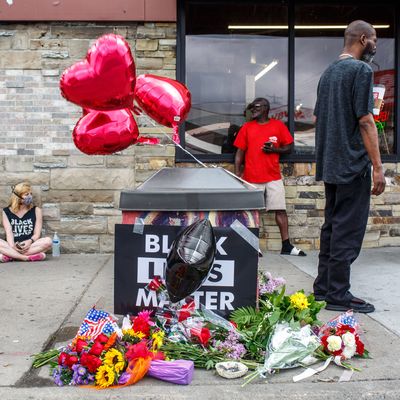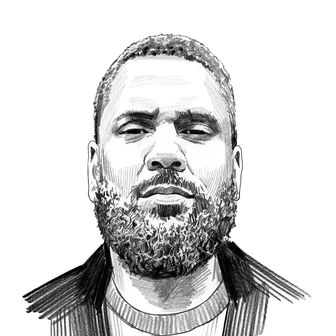
The last few months have acted as a stress test for American institutions, which have had differing levels of success in bearing the weight of the pandemic. Among the most fragile are those meant to promote public health. The most resilient are those that call for public violence, even death.
More than 100,000 Americans have died of complications from the novel coronavirus. This death toll is attributable, in large part, to hapless federal leadership and the inability, or unwillingness, of Congress and the judiciary — the most powerful bodies of which are controlled by the same political party as the president, whom they wish to see reelected at all costs — to protect the public from it. The pandemic’s deadliest days have showed America’s health-care system to be lethally overwhelmed and underequipped; the country’s epidemiological response has been marked by torpidity and misinformation; and bipartisan bias against downward redistribution has slowed the dissemination of relief money, even as jobs and businesses evaporate and millions of people are unable to afford housing or food.
Meanwhile, the question of whether individuals and local governments will treat pandemic safety with a shred of public-spiritedness is often guided by their fealty towards the president and his political agenda, which entails a mix of racist faultfinding and downplaying the virus’ severity to juice economic numbers. The Supreme Court has functionally forced people to vote in person in one recent election to secure a partisan advantage, even as the president seeks to undermine the legitimacy of elections that Democrats might win. All told, it’s become a reasonable expectation that, whenever a public entity is called on to ensure Americans’ capacity to self-preserve in the face of the coronavirus, it will fail to do so — often avoidably — such that thousands of people die or get plunged into financial ruin.
On the other hand, business is booming for police. Even as crime rates have plummeted and American life has retreated indoors, the worst excesses of law enforcement remain ever present in the interactions that still take place. The NYPD has greeted its mandate to enforce social distancing with the same violent zeal and racist asymmetry as it has public-health crises past, like mental illness and drug abuse; several documented examples of officers, many without masks or other protective equipment, arresting and assaulting black and brown New Yorkers while permitting white ones to gather in parks unbothered have circulated online in recent weeks, even as the department refuses to slow arrests to prevent the virus from spreading inside the city’s jails. In Philadelphia, the SEPTA public transit system’s foray into mask enforcement led to immediate abuse — several police officers violently dragged a black man off a train for not wearing a protective face cover in April. In Los Angeles, the police department is set to receive a massive funding increase in the coming fiscal year, per Mayor Garcetti’s latest budget; meanwhile, civilian employees are being furloughed en masse, gang intervention programs are getting cut, and an LAPD officer was captured on camera last month punching a handcuffed man repeatedly in the head.
Recent developments in Minnesota affirm the resilience of a law enforcement apparatus that has proved stubbornly immune to the shifts roiling society at large. On Monday, George Floyd was killed by police in Minneapolis. Cell phone footage shows the handcuffed black man pinned to the ground, a white officer’s knee digging into his neck, another Asian-American officer keeping onlookers at bay. Floyd can be heard gasping, “I can’t breathe,” as bystanders beg for the police to relent. The officer’s knee stays planted even as his victim goes limp and unresponsive. Floyd was rushed to a local hospital later that evening, where he was pronounced dead.
Floyd allegedly fit the description of a man suspected of forging checks — a crime that, if it happened, renders the police response even further out of proportion than it seems at first glance. Still, there’s nothing particularly unusual about it. In a typical year, American law enforcement officers kill close to 1,000 people. Many of the pretenses used to justify these deaths hinge on such thin evidence of their necessity that police rarely have to do more than claim fear to secure their exoneration. The mayor of Minneapolis has condemned Floyd’s killing and the FBI is investigating it. The officers involved were fired on Tuesday, and hours later hundreds gathered to protest Floyd’s death. But it’s the latest in a string of violent incidents perpetrated by police against the most vulnerable of a pandemic-wracked populace, which continue to occur even as opportunities to do so diminish in frequency.
This dynamic was foreseeable after decades spent by elected officials slashing social services and expanding law enforcement, the latter of which was already being applied with racist asymmetry. But the gap between how quickly so many Americans have had their lives upended by ill health, job loss, and other forms of precarity, and the minimal interruption to how law enforcement conducts its usual business while its agencies get more funding and expanded powers, is among the more telling features of how the pandemic has unfolded. George Floyd was a casualty of the resilience of vicious policing, at a time when the national circumstances support a vastly diminished role for law enforcement in daily life. Were this resilience to be exchanged for that of an adequate social safety net and able bulwarks against inept leadership and eroding democracy, the consequent drop in American deaths would be astounding.






























